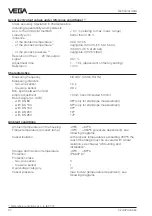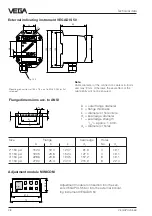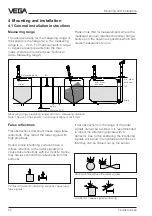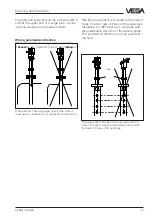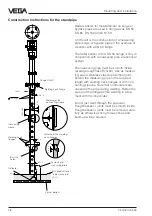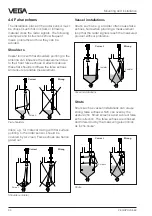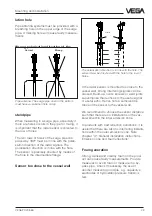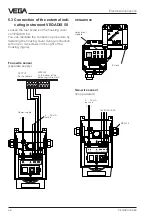
VEGAPULS 56K
33
Reference pane
Mounting on dished vessel end
Reference pane
1
/
2
vessel radius
Mounting and installation
Mounting directly on flat vessel top
Dependent on the construction of the vessel
(sensor weight), flat mounting directly on the
vessel top would be a favourable solution. The
top side of the vessel is the reference pane.
4.3 Measurement in a standpipe
(surge or bypass pipe)
Do not mount the transmitter in the centre of
the dished end of the tank or close to the wall
of the vessel, but approx.
1
/
2
vessel radius from
the middle or from the outer wall of the vessel.
Dished tank ends can act as paraboloidal
reflectors. If the radar sensor is placed in the
"focus“ of a parabolic tank end, the sensor
receives amplified false echoes. The radar
sensor must be mounted outside the "focus“
hence parabolic amplified echoes are
avoided.
Sensor directly on the vessel top
Mounting on dished end vessel
>␣ 10␣ mm
General instructions
Pipe antennas are an option in vessels which
are mechanically complex or where the prod-
uct surface is very turbulent.
By focusing of the radar signals within the
measuring pipe, also products with small
dielectric constant figures (
ε
r
= 1,6 to 3) can be
reliably measured.
The surge pipes which are open at the bottom
must extend over the full measuring range (i.e.
down to 0% level).
Suitable will be a deflector at the tube end.
The medium is therefore reliably detected in
the range of the min. level. This is mainly
important for mediums with a dielectric con-
stant figure of less than 5.
Also note the required vent in the surge pipe.
These vent or compensation holes must be in
one axis with the hole in the intermediate


